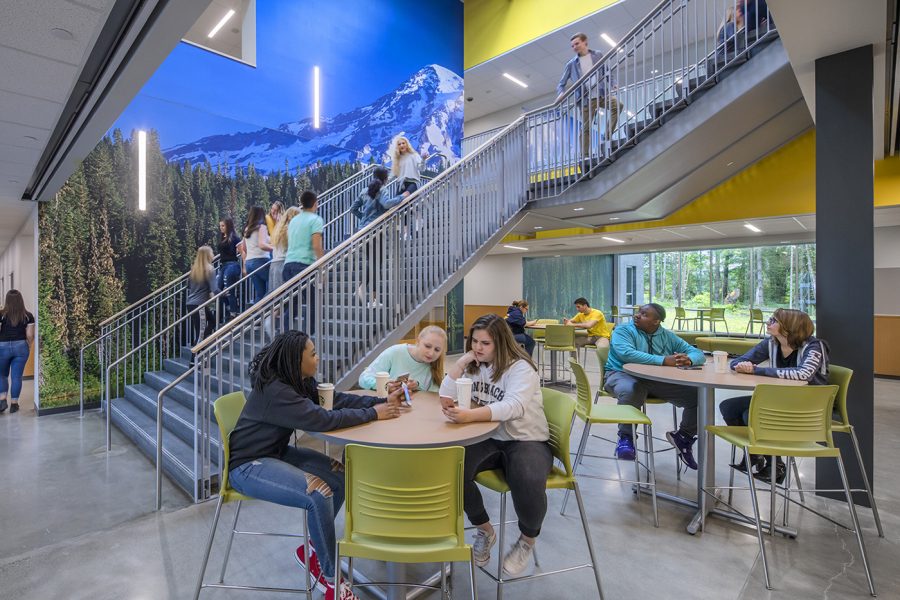Student Conflicts and Resolutions at Tahoma
How students and the school can work harder to make the school a more community and less conflict driven environment.
Photos by Chris J. Roberts Photography, Courtesy DLR Group
Picture of Tahoma students in the project areas of Tahoma. Taken from the Daily Journal of Commerce website. http://www.djc.com/news/co/12103445.html
January 22, 2018
Human conflict is inevitable, that is a given. Considering everyone has different experiences and personalities it makes sense that some people would clash. But, what does that mean for high school students? In such formative years as high school, it is important to learn life skills such as how to resolve a conflict how to learn to get along with other people.
The issue is not whether or not problems exist, the issue is that sometimes students feel that their problems are not completely resolved. Some situations are “easy” to resolve, such as an argument between friends can be understood and overcome. A scheduling issue can be taken care of and fixed efficiently and not be a problem again. However, when it comes to larger conflicts, the counselors and administration may not always have the power to help the students as much as they want. The job of school counselors and administrators is to provide students with the means to remain healthy and safe both physically and mentally. In some cases, this is not always possible. Some conflicts may feel unresolved because the very nature of them calls for further or less involvement from the school. For some issues once the school is made aware of the issue, they can solve it with only one of the students after hearing both sides of the story, other issues require more detailed solutions and parent involvement.
A counselor’s job is to give students resources that they can use to solve problems and work as a mediator for conflicts that cannot be internally resolved. Some students who have gone to the counselor for help with larger issues have come away from it feeling that the issue was not resolved completely. Conflicts vary in the degree of severity, therefore, it can be difficult to judge when adults need to be involved. Counselors can help with internal conflicts such as panic attacks, sexuality issues and trying to switch classes. However, when it comes to external issues, the counselor may not be able to help in every situation.
Studies show that schools that help to resolve problems have “improvement in academic achievement, reduction in time spent in discipline, financial cost savings as a result of fewer absences, and overall improvement of school climate” according to the Ohio Conflict Management Initiative. They have also found that violence decreased and classroom management became easier for teachers and students social and emotional development was enhanced. These schools made it easy for students to find ways to resolve their conflicts peacefully and calmly. Peaceful settlements also reduced the chance that the conflict will become a problem again, stopping people from stressing about the effort that they are facing.
A growing problem in recent years had been bullying, specifically cyberbullying. Studies have shown that students age 12-17 have reported an increase in violence in their school. One Of The most common types of bullying is verbal abuse, with 77% of students reporting that they have been verbally bullied at some point, sometimes very often. In today’s society that hinges on the internet and social media, the worst form of bullying is cyberbullying. That is a term that everyone has heard, but if they haven’t seen it happening, done it themselves, or experienced it, they tend to not pay too much attention to what it actually entails. About 80 percent of students have reported being bullied online at least once. As student-led school shootings have increased, a large amount of the students involved claimed that they were trying to get back at someone for something they had said online. About half of teens have said that they have at least once said something hurtful online. Unfortunately, 85 percent of teachers have stated that there was little or no teacher or counselor intervention in the bullying, whether online or in person.(bullyingstatistics.org)
A student, who for the purpose of keeping her identity private will be called Taylor, told a story about a time when she needed school involvement and little was given. Taylor had been harassed by two other students. After telling a teacher about the situation said teacher brought it to the administration. Taylor was brought down to the office and told them what the other students had been doing to her. They promised her that something would be done about it, but nothing improved. The other students continued to harass her, making Taylor feel uncomfortable around anyone that she was not close friends with. Taylor returned to the counselor and pointed out the two students in the yearbook, and described the clothing that she had been wearing when she was harassed. The counselor promised that she would call her parents to let them know of the situation and no such call was ever made to their knowledge and the knowledge of their parents. The issue was not resolved the way the counselor told her that it would be and in the process, they stopped wanting to come to school because the issue was making her feel uncomfortable in the hallways.
Another student, who will be called Carter, was in a situation where they were being sexually harassed by another student. Carter told the counselor and a teacher that they were close to what had been happening. The counselor described what was in their power to do and asked what she wanted to be done. The counselor talked to the other student to get their side of the story and the student has likewise punished accordingly. Carter says that “in the end, I was happy with the counselor’s decision, though the thought of the situation still bothers me.” The situation was resolved to the best of everyone’s ability and Carter no longer had to worry about it.
The issue at play here is not that conflicts exist because they always will. The problem is the severity of the conflict and what approach needs to be taken. In Taylor’s case, the other two students that were harassing them, made them feel uncomfortable and stressed, yet it was not labeled as sexual and was therefore resolved with less drastic measures. Carter, on the other hand, had sexual advances made on them that made them extremely uncomfortable and could not resolve the situation on their own so the counselor stepped in to help. These two stories are very could cases of legitimate conflicts that needed resolving and yet only one of the parties actually felt that the issue was completely taken care of for them.
When I asked the counselor for a quote on this, they told me that they were not the ones who mostly dealt with this situation. They instead referred me to Ben Todd the dean of students whose job it is to handle situations ranging from peer conflict (an argument between friends) and larger issues such as bullying or harassment. He said when it came to helping students learn to deal with these situations is that “students need to have someone that they trust, there has to be a staff member that they’ll go to.” Whether is it bullying or peer conflict, if the students do not have someone they feel that they can trust, they won’t report the situation. He also said that it is important for students to understand what the definition of bullying and harassment is. If you find yourself questioning what the definition is, it is in the student handbook. Mr. Todd continued, stating “If you are not sure if you are being harassed or bullied, but you’re just frustrated, always report.” From there the school can help you determine the magnitude of the situation and whether further school involvement is necessary.
Conflicts are such an interwoven part of the overall high school experience, therefore, they sometimes fly under the radar. Unfortunately for some people that means that they don’t even know how to bring up the problem to people in a position to help them. The counselors at our school are there to help with issues and if they are unable to help there are administrators who are trained to help with conflict resolution. Even if the conflict may not always feel completely resolved it is important for students to be able to learn the skills that why can use now and in the future and use to teach younger generations then them. Students can help themselves and others by learning and use the tools that the school tries to provide so that students can feel safe while learning at Tahoma.
Nobody is perfect, that includes teachers and administrators. When presented with an issue they do their best to protect the interests of everyone involved. Though sometimes situations make that difficult. So while some students may feel that their conflict does not get fully resolved for the most part the school is able to at least get some resolution. Of course, it could always be better. School violence and bullying have always and most likely will always be an issue. Many say that is the nature of high school. What if instead of always giving someone an insult we look for something about them that we can compliment? Instead of fighting because someone put us down or said something we didn’t like, we could talk to them and understand why they did what they did. It is true that after we graduate it is highly unlikely that we will keep the same friend group our whole lives. But, while we are here at school we should work harder to be nicer to each other so that we need counselors and administration less for dealing with fights and arguments, and mostly for guidance about what career we want or what classes we should be taking.



